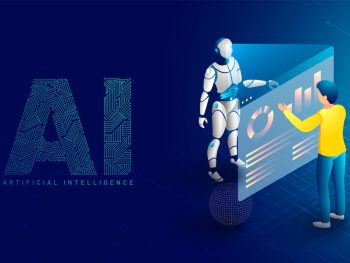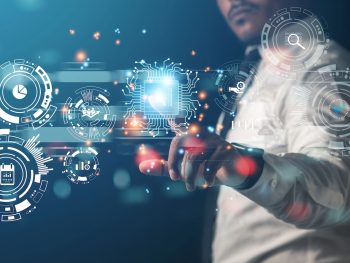Artificial intelligence tools for transportation and logistics success
The global transportation and logistics industry is gaining significant advancements with innovative AI-backed tools. Dive into the transformative effects of artificial intelligence, from automating complex logistics processes to optimising vehicle tracking in automotive telematics.

Next-generation automated tools for transportation and logistics emerge are powered by artificial intelligence
The global logistics industry is worth well over an estimated $11 trillion. From a macro perspective, transportation and logistics make for the third-largest economy in the world. Simply put, this market is one of the most complex and involved.
Think about it this way: every single piece of clothing your teenager buys or new gadget your partner picks up for around the house must travel from a manufacturer to a distributor to the last mile until reaching your doorstep. That coordination of steps has traditionally involved countless connections and networks, but what if there was a way to improve such systems through automation?
This thought has been at the heart of technological advancements, and now, a suite of next-generation automated tools for transportation and logistics emerge – tools powered by artificial intelligence (AI).
A continued dedication to finding ways to enhance the performance, efficiency, and accuracy of vehicle tracking ensures the telematics industry continues growing rapidly. This article will delve into how AI tools can shape the future of the transport and logistics industry and how AI is already influencing these sectors.
Exploring AI potential in modern-day logistics
Before we look closer at transportation in general, consider the improvements of AI through logistics.
Warehouse automation
Warehousing is a cost-heavy logistics system. It often involves complex software and human management to ensure the continual flow of goods from source providers to managers and into the waiting vehicles of delivery trucks.
With AI-powered robots, automation and cost savings are introduced into the system.
Instead of mundane, repetitive tasks taking up valuable time from human workers, AI-powered robots can efficiently sort, pick, pack, and organize inventory. The result is a significantly faster order fulfilment process that ensures items are sent out on time.
One other important point to note about these robots is accuracy. Most warehouses experience between 1% and 3% of an error rate.
That may not seem like much, but it results in complicated client issues, mis-deliveries of goods, and lost profit due to returns. A robot doesn’t make as many errors due to being tired or needing a break.
Self-learning supply chains
Another crucial aspect of logistics is the current web of supply chains being utilised by a company. While there is human insight that can find new efficiencies, AI provides exponentially more detailed reporting – effectively uncovering information a human would miss.
Over time, these AI-backed supply chains can learn more about how operations flow. New ways of smoothing out planning, procurement, inventory management, pick & pack systems, and product distribution unlock cost savings and streamlined delivery times that end clients appreciate.
Steering towards progress: AI in modern transportation
While logistics is certainly an industry needing AI integration, physical transportation of goods is crucial to so many countries reliant on trucking and roadway supply chain management.
Autonomous vehicles and drones
In 2019, over 31 million cars were on the road with some form of automation. Since then, companies such as Gurtam have created new systems that have exploded the market.
Add to that system the remarkably quick development of lighter drones that can carry more weight, and you will have a recipe for transformation.
Even now, major brands such as Target, Walmart, Amazon, Chick-fil-A and more utilise drones and autonomous vehicles to make deliveries in urban environments.
These vehicles range from small concepts you could fit a dog inside to full-sized SUVs for human transportation.
The more streamlined developers such as Gurtam make the transportation industry automated, the less we have to worry about tired drivers, accidents, and lost packages – especially when you combine such telematics with real-time GPS tracking through tools such as Wialon.
AI-driven route optimisation
A key challenge of modern transportation is route optimisation. Too often, consumers receive notifications of delayed deliveries due to crashes blocking roadways, extreme weather, construction zones, or good old-fashioned rush-hour traffic.
Infusing such delivery routes with AI ensures packages are rerouted in real time to the best possible pathway for delivery success. Artificial intelligence improves the accuracy of deliveries and can update transportation managers as well as customers on where packages are located at any time of day or night.
Best of all, that data can then be analysed from a holistic perspective, unlocking new efficiencies through route optimisation planning for the future.
Predictive analysis
Predictive analysis is a time and money saver.
Using AI to comb through mountains of data points allows fleet management software to be updated with all kinds of proactive information.
You could ensure that vehicles are better maintained by flagging those cars, trucks, or flatbeds requiring maintenance long before a driver notes a flat tire or oil change on the horizon.
Even something as little as noticing a route that places more demanding stress on a vehicle’s infrastructure can be managed through predictive analysis.
Maybe going five minutes slower via a safer roadway with fewer potholes ensures less vehicle maintenance that can save a company millions in the long run.
Classification
One of the more interesting areas of AI in transportation is how it can discover patterns human minds have yet to detect.
For example, uncovering a pattern between unrelated vehicles within a fleet and then grouping them based on those same attributes to save time and money.
You may have a three-tier system of transportation in your local region.
The first is within five miles from your distribution, then 15 miles, and finally 25+ miles.
While it makes sense to group your vehicles based on the distance they travel, AI could open up new patterns by the fuel they use, the speed they travel, or the pressure put on the vehicle during transportation.
Computer vision
Not all systems are foolproof. A single AI-based tool can and will fail. The trick is finding ways to introduce redundancy so information can then be used to improve. Instead of placing blame on a driver for something going wrong, you are viewing these tools as new opportunities to improve.
When a GPS tracker goes wrong because it thinks a vehicle is idling, new AI tools can help analyse the visuals around the vehicle, like what a human is doing at the time or how the car is actually moving, to extrapolate what went wrong. Once these mistakes or failures are brought to light, additional data can help outline how to make positive changes to avoid such errors in the future.
UI and customer experience: Gurtam case study
Increasingly, artificial intelligence is reshaping customer interactions in exciting ways, seen in products such as Flespi and Wialon from Gurtam, a company known for providing comprehensive telematics software solutions.
As illustrated by Flespi’s services, AI can be an essential support assistant, supplying device-specific advice to address complex customer questions. This is possible through large language modelling (LLM) which processes text and offers human users vital clues via Retrieval-Augmented Generation (RAG). Flespi’s AI-powered assistant can handle more specific questions about the installation of telematics hardware, maintenance of vehicles, or the operational efficacy of integrations.
From Wialon’s experience, AI tools can also help manage GPS tracking hardware configurations. Moreover, AI tools can manage comprehensive project documents such as safety questionnaires much faster than a person can. Looking ahead, Wialon aims to use AI assistants to automate the handling of tech support tickets, further improving customer service.
Final thoughts: Harnessing data to fuel AI in automotive telematics
The infusion of artificial intelligence in the transportation and logistics industry is no longer a future prophecy but a reality that’s already transforming the sector. However, to truly harness all of these impressive AI capabilities, the key ingredient is data. Without these, companies risk being left out of the AI revolution.
For example, Wialon operates with more than four million tracked units all over the world. The number of tracked units is only predicted to grow, with Statista forecasting more than 400 million connected cars in operation by 2025.
This huge amount of data stands as a promising resource, which could pave the way for simplifying the process of gaining insights for customers in the near future.
With innovative AI-backed tools, the future of global transportation and logistics is brighter than ever. Finding ways to use more updated information based on data gathered through automotive telematics ensures the decision-making we rely on for receiving goods only improves.
As companies continue to innovate and onboard new technologies, we are likely to see more and more new AI systems introduced into this industry. It is exciting to live in a time when supply chains open up opportunities for businesses to start, grow, and establish themselves – all with full scalability and insights from AI tools.
Artificial Intelligence (AI)Automated tools for transportation and logisticsGurtamWialon






